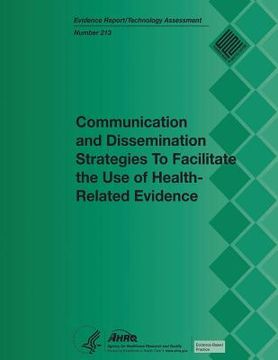Communication and Dissemination Strategies to Facilitate the Use of Health-Related Evidence: Evidence Report/Technology Assessment Number 213 (en Inglés)
Reseña del libro "Communication and Dissemination Strategies to Facilitate the Use of Health-Related Evidence: Evidence Report/Technology Assessment Number 213 (en Inglés)"
The Agency for Healthcare Research and Quality (AHRQ) sponsors research to improve the quality, effectiveness, and safety of health care in the United States. Evidence reports and technology assessments generated through AHRQ's Effective Health Care Program provide science-based information about common, relevant health conditions and technologies to serve the needs of patients, clinicians, insurance payers, and other end users. Evidence reports typically target scientific researchers in related fields, rather than the patients or clinicians who ultimately make health-related decisions. For this review, we view the evidence as moving along a continuum beginning with its collection and systematic review, followed by communicating and translating it for audiences as needed, diffusing and disseminating it, adopting and implementing it, and sustaining and evaluating its impact, with adjustments as needed. We define evidence as data that have been assembled, reviewed, and presented by evidence developers and that have been used to make recommendations. Our review included only the second and third phases in the evidence continuum: communication and dissemination. Clear communication and active dissemination of evidence to all relevant audiences in easy-to-understand formats are critical to increasing awareness, consideration, adoption, and use of evidence, and to accomplishing AHRQ's mission. By evaluating the comparative effectiveness of communication techniques and dissemination strategies, this review informs efforts to make evidence reports summarizing current research both more easily accessible for evidence translators, health educators, patients, and clinicians and more likely to be used to influence individual decisions, change practice, and inform future research. Due to the complexities of our topic, we present separate results for the three separate systematic reviews-one for communication, one for dissemination, and a third for uncertainty-each addressing a separate but related Key Question (KQ). Combined, these three separate reviews provide information on how to best translate and disseminate research-based evidence reports. This systematic review has three related components; all focus on promoting informed decisions about health-related behaviors and decisions among patients and clinicians. First, it addresses the comparative effectiveness of communicating evidence in various contents and formats that increase the likelihood that target audiences will both understand and use the information. Second, it examines the comparative effectiveness of a variety of approaches for disseminating evidence from those who develop it to those who are expected to use it. Third, it examines the comparative effectiveness of various ways of communicating uncertainty associated with health-related evidence to different target audiences, including evidence translators, health educators, patients, and clinicians. Key Question 1: Communication Strategies To Promote the Use of Health Care Evidence KQ: a. What is the comparative effectiveness of communication strategies to promote the use of health and health care evidence by patients and clinicians? b. How does the comparative effectiveness of communication strategies vary by patients and clinicians? Key Question 2: Dissemination Strategies To Promote the Use of Health Care Evidence KQ 2: a. What is the comparative effectiveness of dissemination strategies to promote the use of health and health care evidence for patients and clinicians? b. How does the comparative effectiveness of dissemination strategies vary by patients and clinicians? Key Question 3: Explaining Uncertain Evidence KQ3: What is the comparative effectiveness of different ways of explaining uncertain health and health care evidence to patients and clinicians?

